What to pack and other tips for an easy and fun hike in the desert
Tips for what to bring along on short easy hikes
Hiking in the desert is an absolute joy. There’s sunshine, big blue skies, amazing flora, great exercise, a sense of adventure, and maybe even a few desert critter sightings. But precautions must be taken even if you’re not doing advanced or extreme hiking. This quick how-to-pack and what-to-wear guide isn’t for long or extremely difficult paths or trails. It’s intended for easy to moderate hikes of one to three hours on marked routes. You will have other needs not covered here for extreme or extended hiking.
You should consider adjusting types and quantities of items to meet your requirements if you embark upon longer and more challenging hikes. These are just suggestions and only reflect what has worked for Mr. TWS and me on the easy to moderate hikes we’ve taken so far.
Getting ready to go on your hike
Your hike will be safer and much more fun with the proper hiking shoes/boots, hat, and sunglasses.
Sunscreen – I use Neutrogena SPF30 which works well for me (although my dermatologist may think that’s not strong enough). Be sure to apply prior to starting your hike.
Hat – Experts always recommend a hat to shield your face from the intense rays of the desert sun. I know …. you’ve seen photos of me without a cap (like the photo at the top of this post). I admit I don’t wear one all the time, but I have one with me all the time!
Sunglasses – Of course! Protect your eyes and look cool at the same time.
Good hiking shoes — The trails of the Sonoran Desert can be very rough and uneven with protruding rocks, loose dirt, and slippery stones. You want to have stability and support for your feet and ankles with a good pair of hiking shoes/boots. I love my Salomon mid-height hiking shoes which are lightweight and breathable.
Walking stick — Many hikers bring one or two hiking sticks (even on very short, easy hikes). I don’t, but it’s not a bad idea for balance and being prepared in the unlikely, but possible, event you encounter desert critters.
What’s in my backpack?
Take a look! I hope that this list will be helpful as a general guide and reminder for you to consider. Of course, you’ll want to customize your contents based on your specific circumstances, needs, likes/dislikes, health, and trail conditions.
Simple backpack checklist for your easy hike
Water, water, water!
It’s super important to stay hydrated as you hike. Take frequent breaks along the way to take a few sips before you actually feel thirsty.
“How much you need to drink depends on a number of factors, such as the activity you’re doing, intensity level, duration, weather, your age, your sweat rate and your body type. A good general recommendation is about a half liter of water per hour of moderate activity in moderate temperatures.” — REI advice about hydration basics
Keep a small case inside the backpack with helpful items
Cell phone — Seems obvious, but it’s really important to make sure that your cell phone is fully charged before you head off on the trial.
Trail map — Signs along the trails of the McDowell Sonoran Preserve are good, but in case you miss them or want to get the overall picture of where you are and where you want to go, bring a trail map. Maps can usually be found at most trail heads, but you can go online to download ahead of time.
ID and money — I carry a copy of my health insurance ID card in a small card holder. Although there aren’t any shopping opportunities on the trail, obviously, it makes me feel better to have a few dollars handy.
Lip balm — I like Nivea lip care products and use one with SPF15 or greater.
Small tube of sunscreen — I don’t usually feel the need to reapply sunscreen, but just in case it doesn’t hurt to carry a small sample-sized tube.
Energy/Protein bar – I carry one good protein bar in case my body needs an unexpected energy boost. In warmer weather, you might also want to bring along a small bottle of Gatorade in case you need electrolytes.
Tissues, hand sanitizing wipes or gel, lens wipes, band-aids, and like items — Use your judgment based on your needs.
Dry mouth spray like Biotene – This is something I rarely use, but it’s a very good way to get quick relief if your mouth is feeling dry. It’s certainly not a must, but a nice addition to the backpack.
Bandana — A bandana doesn’t take up much space so go ahead and throw one in. It can make a great sun shade or be used for any number of other reasons, such as wiping away sweat or adding a stylish touch to your hiking gear perhaps.
Pocket knife — Why would I need to carry a pocket knife in my backpack? Because my father would want me to! You just never know when you might wish you had one.
Attachable sun shield for cap — My Outdoor Research Sun Runner Cap from REI has a lightweight sun shield that can be attached to the cap to shade your face and neck.
Atomizer with water for spritzing your face if you’re feeling heated. It’s very refreshing.
Aspirin (could be a life-saver) — Make sure you’ve got whatever medications you may need with you.
Face covering/mask — Although you may not need it outside as long as your fellow hikers are following social distancing requirements, keep your mask handy in the event that you need to put it on for safety.
These tips are representative of what I’ve found to be effective in our personal experiences on the McDowell Sonoran Preserve trails of Scottsdale, Arizona. We usually hike between mid-September and mid-May with temperatures ranging from 50 °F to the high 80s. Your requirements may vary depending on personal needs, location, and climate conditions.
Editor’s note regarding COVID-19: Please be cautious and courteous of fellow hikers by maintaining a safe distance (at least six feet) between yourself and others at all times including on the Sonoran desert trails. Follow CDC guidelines and instructions of your local authorities in all activities during this pandemic crisis.

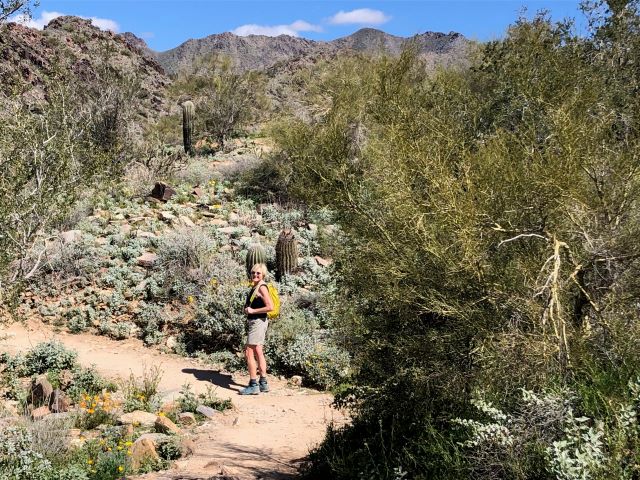

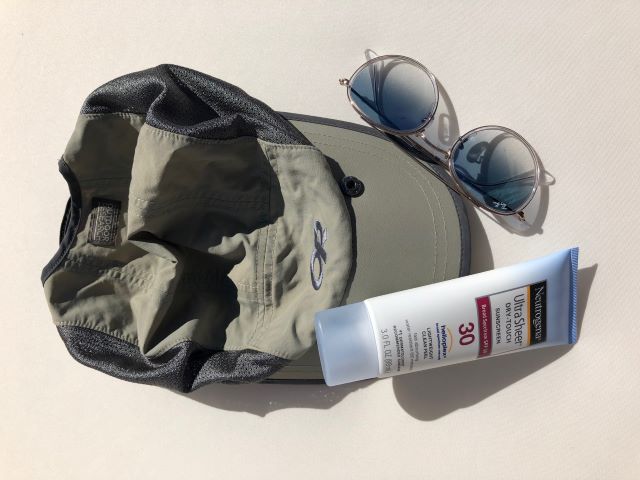
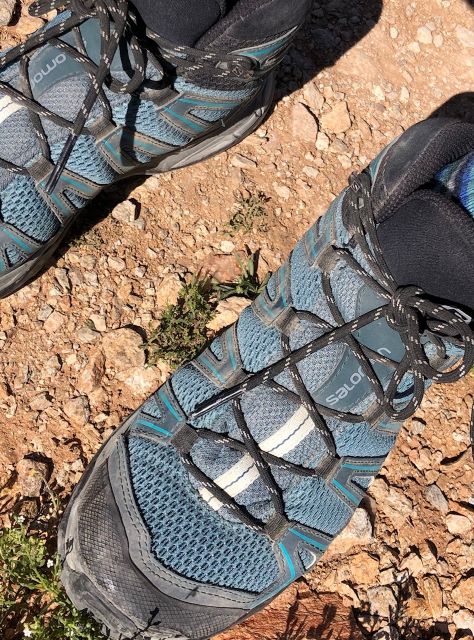
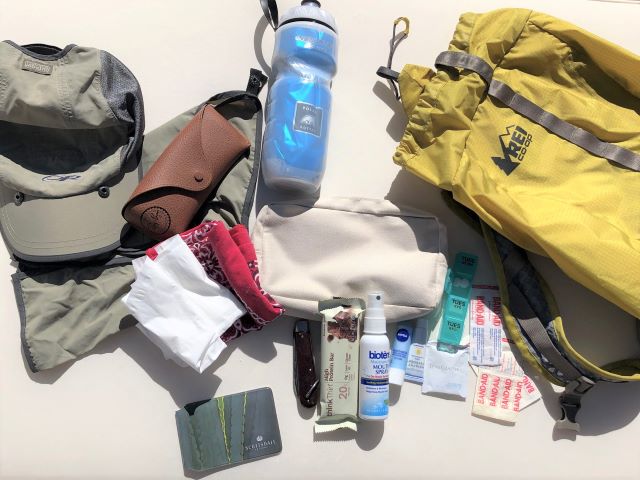
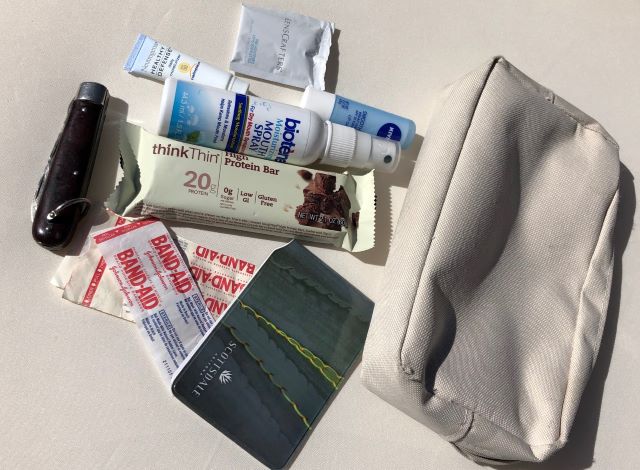
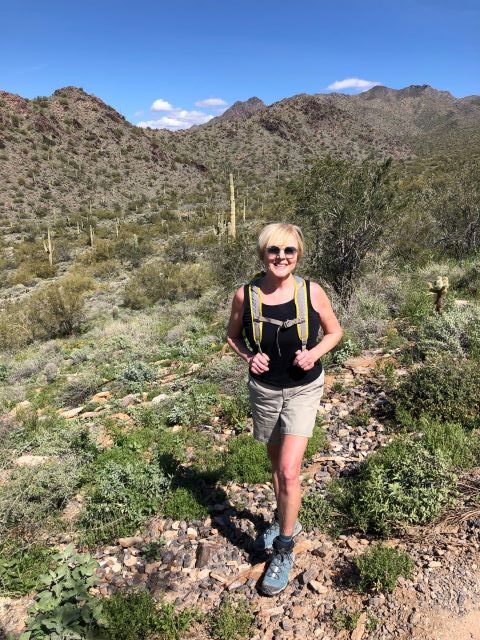
Don’t know if we’ll ever hike a desert but if we do this is a great start. My hubby has that same OR hat and never goes anywhere outdoors without a pocket knife. Also agree with don’t just take water but pack a small atomizer, does wonders in the heat.
Hope you’ll get a chance to try out the trails here in the desert sometime. It’s such an invigorating activity and the scenery is awesome.
Great hiking gear tips, and here’s another one: I always take a photo of the trail map board at the trailhead, just in case. It’s always good to have a backup map of the whole area.
Hey, Jane. Thanks for the tip! It reminds me of being on a hike with my brother-in-law who took photos of some of the trail markers along the way — just in case.
This is a nice succinct packing list for a desert hike. I also use Neutrogena sunscreen because it doesn’t cause skin irritation. My challenge is always deciding how much water to take because it’s so critical but so heavy. Glad you included the guidance from REI.
We kind of learned how much water to take by trial and error the first several hikes, but now have a pretty good idea how much we’ll need based on the temperature and how long we plan on being out. And we always take a little more than we think we’ll need.
Very good article and advice. I would also add a whistle and gum to your backpack items.
Great tips, Marilyn. Thanks!
If your hiking over uneven rocky terrain terrain I strongly suggest two good walking sticks. Just one stumble or misplaced foot saved by your walking stick and you will be thankful.
That’s a good point, Charles. Mr. TWS and I really need to consider starting to use walking sticks. Even though we feel very sure-footed, it only takes one false move to create a real problem. Thanks.
Having hiked in that desert I would definitely agree with all the items you’ve recommended. I also carry a roll of that stretchy stuff (name escapes me) that you wrap around sprained ankles – as you’ve noted the paths are good but not a flat surface. Fun read. . .
I like those dri fit, lightweight hats. Only problem is that it is a baseball style cap and does not cover the neck. Voila, your bandana suggestion.
Great suggestions, all! I also recommend a sunscreen stick that I use on my nose and chin. You can’t use too much sunscreen.
Hey, that looks exactly like my day hike trail pack! One more item to consider for longer days: an extra pair of socks. Feet feel so refreshed (and avoid blisters), with a change of socks at mid hike. I’ll pin this too.
What a wonderful list of tips and information! You sure seem to have made a wonderful adaptation to Arizona!
Pingback: Our Top 5 Scottsdale Hikes ... So Far | Traveling with Sweeney
Great tips on what to bring for travel accessories especially in your environment, must be nice to be outdoors now.
Thanks for compiling this useful information for desert hiking. We are hoping to spend some time in 2021 doing a little of this and your article gives us some advice that should make our experience successful
I’ve never been desert hiking but I can imagine that water and a hat are essential!
Thanks for the great packing suggestions–I never would have thought about carrying dry mouth spray, but it makes sense for desert hiking.
Love your post, Cathy. I’d love to be on the hiking trail in a nice warm climate right now. Our temperatures (in Manitoba) have been hovering around the freezing mark for most of this month and winter is definitely knocking on our door.
A hiking stick is necessary for a hike. I bought one this year with the hope of hiking locally in England but it didn’t happen due to the pandemic. Thanks for the tips
Hiking is uppermost in my mind since we are trying to do more uneven trails to assist my husband with his stroke recovery! While we’re not in an arid desert situation at the moment your outline of what to take is still very pertinent to the basic supplies one should carry on board – Thanks for laying it out so clearly 🙂